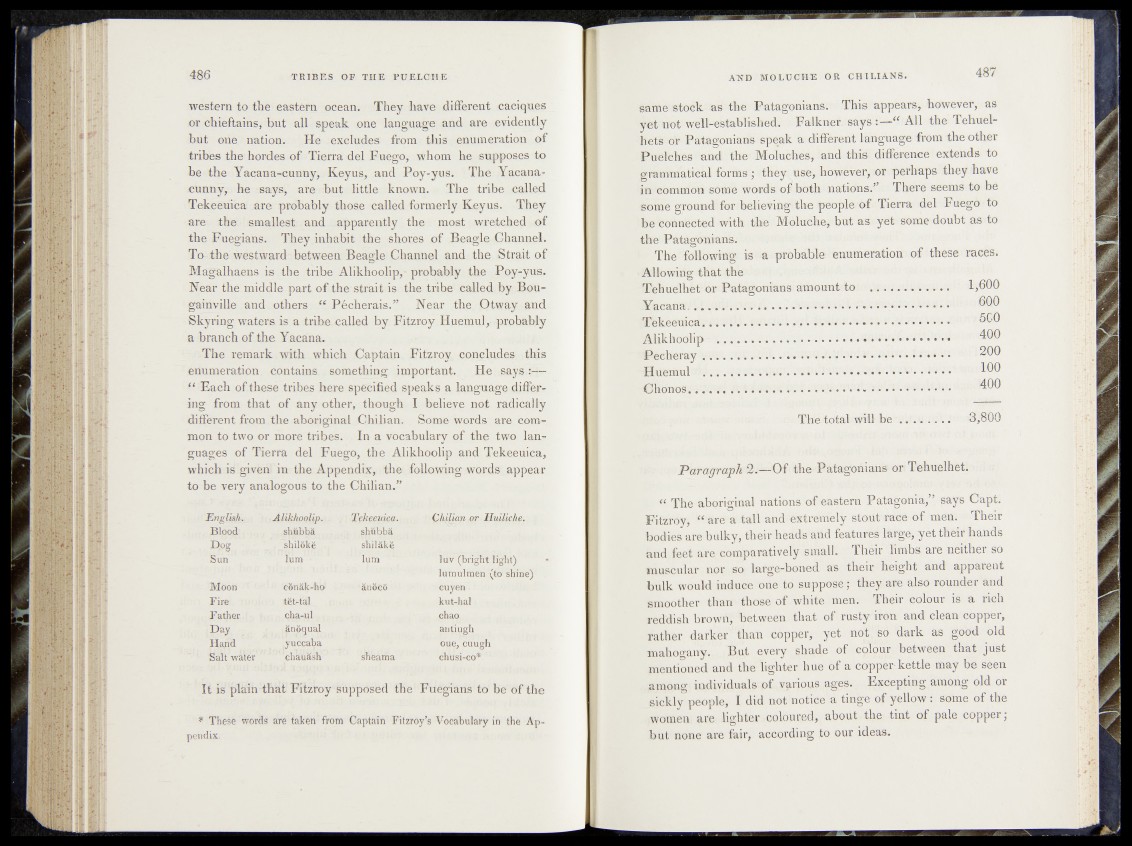
western to the eastern ocean. They have different caciques
or chieftains, hut all speak one language and are evidently
but one nation- He excludes from this. enumeration of
tribes the hordes of Tierra del Fuego, whom he supposes to
be the Yacana-cunny, Key us, and Poy-yus. The Yacana-
cunny, he says, am but little known. The tribe called
Tekeeuica are probably those called formerly Key us. They
are the smallest and apparently the most wretched of
the Fuegians. They.inhabit the shores of Beagle Channel.
To-the westward between Beagle Channel and the Strait of
Magalhaens is the tribe Alikhoolip,- probably the Pey-yus,
Near the middle part of the strait is the tribe called by Bougainville
and others “ Pécherais.” Near the Otway and
Skyring waters is a tribe called by Fitzroy Huemul,- piobnbty
a branch of the Yacana.
- -The remark with which Captain Fitzroy epnolndes: iffris
enumeration contains something important. . JjUt sayssl^--
^TSach of these tribes here specified speaks a langunil© djfp§ïv
ing from that of any other, though I believe not radically
different from the aboriginal Chilian. Some words are eerm
mon to two or more tribes. In a vocabulary of the two languages
of Tierra del Fuego, the Alikhoolip and Tekeeuica,
which is given in the Appendix, the following words appear
to be veiy analogous to the Chilian.? ;
English. Alikhoolip. . Tekeeuica. ' Chilian or| Huiliche. j j
BloojJ’ ; shübbä , shübbä
H o g _ ! shilökë sbilakë
Sun turn * lüm ; ’ lu Y 'b rigfuifgiit)1 ‘ '
lufmrlmen (to shine)
Moon - eünäk-fed -änocö euyen •
l ’ire ; ! > tët-tal kut-hal I
F a th e r çha-ul chao
iP a y h änöqual autiugh
H an d yuccaba oue, cuugh
Salt wafer ' cbaüäsh sbeama chusi-co* ;
It is plain -that Fitzroy supposed the Fuegians to be of the
* These words are taken from Captain Fitzroy’s Vocabulary in the Appendix.
same stock-as the Patagonians. This appears, however, as
yet not well-established. Falkner, says “ All the Tehuel-
hetSo'r Patagonians speak a different language from the other
PhftlchiS and thé1 MoluefeeS, and this difference extends to
grammatical forms ; -,tK’feyt.®sey however,’for perhaps they have
in common some words of both natfeii^î There seems to be
•some ground for believing: the peoplnOT Tierra del Fuegdr- to
be connected with the M@luche,but as if yet ; some-dnubtas! to
the Patagonians. ;
The-following is a probable» Enumeration of these races.
A1 lowing that the
Tehuelhet or Patagonians amountdo . . . . d*fÜQ
,Yacana; U . ; W®. . . . . m i ^ ï , ei»™«*»
Tekeeuica. . .. ; . . ; . . . . ivw . - v * i-
Alikhoolip- ............................................ .. .* 4®®
Pecheray . . . . ; ..........'.V . ï . .'vi».. Sc»*«;*! i%00
-Huernul m...» w .-..w.-. p i v; . . . . . . . . . . W.. f ig100
Chonos...-... . . . . . ------------------- -M 400
The total will be .».v i .’" i3|80O
P um g ra p h Z ^O f! the • Patagonians ors Tebaelfeetl > u
?; o The aboriginal nations of eastern Patagonia/* says Cfept.
Fittroy, k<are a-tall and extremely stout race of men. Their
bodies are bulky, their heads and features large, yet th^f'hands
and feet iM^nompamtivel'y small. Their limbs are niather SO
muscular nor. so large-boned as their height and apparent
bulk would induce one to suppose; they.are also rounder-and
smoother than those of white men. Their bolbur is a rich
reddish browii * between that-of rusty iron and clean'copper,
rather darker than copper, yet not Hid dark as ;go'Od old
mahogany. But every- sh^d.e ©f^c^lQU|ybetween that just
mentioned and the lighter hue of a copper* kettle rOay be Seen
among individuals of various ,ag©.s.. Ffcepting/piang old ot
sickly people, I did not noticed, tinge of yellow : sotae of the
• women are lighter . coloured, about. the tint of pale copper,
but none are fair, according |o our ideas.